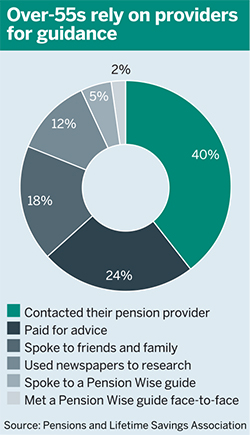Eight panellists discuss the new defined contribution code of practice, the future of free guidance and the role of behavioural finance.

The new DC code of practice has come into force. What has changed?
Andrew Cheseldine: It represents a substantial improvement on the old version; it is less prescriptive in a ‘box-checking’ sense and brings the code up to date following the introduction of freedom and choice.
The main differences in content are the removal of requirements that were difficult (or sometimes impossible, such as communicating the level of FSCS cover) to comply with.
DC members have probably been investing out of earnings that have largely flatlined for the best part of a decade, into funds with opaque fees and with investment performance that has not exactly been compelling
Neil McPherson, Capital Cranfield Trustees
This rationalisation process does not mean member protection is being weakened. The introduction of requirements for a mandatory annual chair’s statement, including value-for-members assessment, will ensure a continuing focus on improving members’ security, understanding and outcomes.
Paul Macro: The biggest change is the need for trustees to actually think about what they are doing for their own scheme, rather than simply ticking boxes on generic actions.
This could be a real challenge for a number of trustee boards to really get their heads around what running a DC scheme actually means, and what their members and the regulator actually expect them to do.
In addition, there is a greater focus on ongoing actions and review. This increased requirement to invest time and effort in running a DC scheme may lead to many asking the question why they are doing this when some quality mastertrusts are now in existence (although there are some that are less ‘quality’, but that is a different story).
Alistair Byrne: The new code is simpler and clearer. It is more focused on setting out the requirements of the law and accompanied by in-depth guides that set out best practice in the various topic areas. This new format should be easier for trustees to navigate.
John Wilson: The new DC code is shorter and simpler than its predecessor and has been updated to include the DC flexibilities and governance legislation introduced in April 2015.
Helpfully, it is supported by a series of how-to guides, which provide practical information for meeting the standards set out in the code. In addition, the regulator has provided a useful tool to help trustees assess their scheme against the standards, so that they can identify areas requiring improvement.
An updated compliance and enforcement policy for occupational DC schemes has also been published. It describes the regulator’s expectations for compliance with legislation and how it will enforce the law.
Trustees should now assess their scheme against the code on an ongoing basis and make any necessary changes to their processes.
Steven Charlton: The new code of practice has a greater degree of clarity. But more interesting is the content of the six how-to guides for use when working with the code, particularly the investment governance guide.
This guide includes nods in the direction of pension freedoms in the ‘Setting objectives and strategies’ section, pointing out that strategies should include both the accumulation and payout phases. This sounds obvious, but it has not been the case in the past.
The ‘Fund and strategy performance’ section highlights a theme that the industry has struggled with for many years: how to assess the performance of lifestyle options given that they are so individual, despite being seen as a default for the masses.
However, it is the ‘Security of assets’ section that should have DC schemes most focused. The guide suggests trustees should not rely on the protections they think they have for DC investments, but instead should understand what they do have.
This brings into focus the interaction of life funds; the FSCS; the way trustees access funds and the platforms they sit on. This is not an easy subject.
Seeing the number of references to target date funds in the document under recent developments and off-the-shelf solution topics, while not an endorsement by the regulator, was pleasing to see.
Neil McPherson: The unlamented 31 quality features have gone, to be replaced with a crisper structure built around the six key DC principles, together with handy reference to relevant regulation.
It also updates the code with key recent legislative change, most notably the chair’s statement and value for money.
The value for money guidance is not prescriptive, but neatly dovetails with the code’s core sections on scheme management and governance, administration, investment governance and, in particular, communications, with a strong emphasis on member engagement through active and effective communication.
The how-to guides and assessment framework complete what is a comprehensive, proportionate turnkey package for good governance of DC schemes.
Ian McQuade: Everything, but very little. The new code of practice 13 is fundamentally different. It is shorter, clearer, more focused and does not repeat what is written in law. It is also much better structured than before.
However, much of the content and the activities that need to be undertaken to run a good-quality DC scheme are as they always have been.
You need trustees with the right skills and expertise, doing the right things at the right time, having the right suppliers and advisers supporting them, and giving members all the information they need in a way that allows them to make informed decisions.
The new code, and the guides that support it, along with the 21st century trustee agenda, set out the expectations of trustees, and the regulator is clearly expecting DC scheme trustees to raise their game. Let’s hope it has that impact.
What will free pension guidance need to look like in the future?
Cheseldine: It is notable that, according to the Financial Conduct Authority, many fewer people are now seeking guidance before they take their benefits. That may be because they now understand that taking guidance is not a precondition of obtaining payment.
At the moment it seems the majority of people are making rational decisions, although there will always be a minority who misunderstand the tax system or who completely underestimate their life expectancy and income requirements.
It is difficult to see how guidance, especially at the level it is currently funded for, can eliminate or even significantly reduce the negative events.
In the short to medium term it looks like the only option will be to monitor decisions in case decision-making deteriorates.
Macro: The current approach targeted at retirement will need to be expanded significantly to both pre-retirement (how much to contribute, how to plan for retirement itself etc) and post-retirement (how to manage drawdown in a sensible and sustainable way).
The main issue though will be how much can be delivered ‘free’ and whether there is any real demand from members – take-up of Pension Wise has been much lower than anticipated.
In practice I think that the baton will have to be taken up by the providers with ‘free’ guidance being built into the products – yes, we all know it’s not in fact free – but it can be delivered in a cost-effective and more personal and relevant way, and I strongly suspect would get higher use than Pension Wise has to date.
Byrne: Our recent ‘New Choices; Big Decisions’ research, tracking DC scheme members making decisions about accessing their retirement assets, found that the Pension Wise service was well regarded by those who used it, but relatively few people found their way there.
That suggests the guidance model is largely in place, but we need to do more to help people to engage with the rebranded approach.
Wilson: Bearing in mind there will need to be recognition that saving for later life is about more than just pensions, guidance will need to take into account other ways that individuals can provide for retirement.
It will also need to encompass later working lives as the lines between work and retirement become increasingly blurred.
And of course there is the prospect of the secondary annuity market, although its introduction by April 2017 is now looking very challenging.
It is difficult to see how guidance, especially at the level it is currently funded for, can eliminate or even significantly reduce negative events for members
Andrew Cheseldine, LCP
Charlton: The idea of free pension guidance is admirable and, as it currently stands, the guidance is going to be invaluable, as many who will engage with it will have little or no idea where to start retirement planning.
A couple of thoughts are: extending the use of the guidance to a wider range of services; and perhaps helping people who are 15 years from retirement understand how likely it is that they will able to maintain their lifestyle in retirement, based on savings so far.
With 15 years to go, you might say that someone who has undersaved has time and hopefully resources to be able to rectify their position.
This issue will become more acute as greater numbers of people head towards a retirement based on DC savings alone, and without the comfort blanket of defined benefit.
McPherson: Free pension guidance, as opposed to advice, will be relatively easy to achieve and access – providers will wrap it into their offering replete with all the necessary caveats and small print.
It will also be delivered digitally via the much vaunted robo-advice. However, while it may be free it will not be independent and, as such, may not be fit for purpose.
Moreover, the providers will recoup their costs through garnering the resultant flows into their products, which will be the likely destination of the free guidance.
Independent guidance (and advice) will generally not be free – the government’s Pension Wise service being a clear exception.
It will come with a cost, either explicit through a fee or implicit through provision as part of a wider relationship, and the destination may be the same.
Either route is better than no guidance – particularly with the complexities, risks and fiscal implications unleashed by freedom and choice.
McQuade: The take-up of Pension Wise has been much lower than hoped, but maybe that is because we are not good about talking about our personal finances.
‘It’s all right, I can find out from the internet’ or, ‘Well, that’s what it said in the newspaper’ are two regular refrains.
Research would indicate that free guidance delivered through the workplace is likely to be the most popular and trusted way forward. Creating links between Pension Wise and workplace guidance would therefore be a good start.
Positive stories may start to emerge of the benefit of spending time talking to someone and really getting a good understanding of the options.
And it is those stories of how Pension Wise, or whatever ends up in its place, have helped people make good decisions that will drive people to use the service.
Does the ‘discouraged investor’ exist? What role should behavioural finance really play in DC default funds?
Cheseldine: Undoubtedly they exist, but there is not much evidence that they exist in great numbers at the moment. But then what reason would they have to be discouraged?
Since the Brexit vote, nearly all asset classes have shown positive growth, and DC members have typically seen a 10 per cent or greater increase in fund values.
However, that is a very short-term perspective. In due course we will see significant market falls, and it is at that point we can expect to see the emergence of larger numbers of discouraged investors.
At that point our role will be to point out the positive effect of the growth before the fall.
In the meantime, we need to balance our view; default options should focus on long-term expectations but with an eye on shorter-term volatility to avoid opt-outs.
Macro: The two main themes of behavioural finance are ‘nudge’ – we can guide people towards making a decision – and ‘inertia’ –most people won’t change a decision made for them and probably would not have made the decision in the first place.
For the latter group the default approach in DC is absolutely vital – but because these members will not change their investments, the default fund must be flexible for them.
Therefore, white label funds or target date funds should be used.Single fund lifestyle approaches really have had their day because if a change is needed, members will not action it.
We do however need to identify those members who would like to, and perhaps should, be making a decision away from the default, or even just their target retirement date.
Perhaps these are the current ‘discouraged investors’, who want to make decisions but have given up because ‘it’s too hard’.
They can be assisted by guiding them towards better decision-making through simple quizzes or layered investment options.
Byrne: Most DC members are savers rather than investors – they know they need to save for their retirement, but are put off by the thought of having to make complex investment choices.
Automatic enrolment helps people overcome the inertia that prevents them from joining a pension plan, and a well governed default fund removes another behavioural barrier by simplifying the investment choice.
While some members end up in the default fund without any conscious thought, others will be happy that there is a fund available that is designed by the trustees or provider to be broadly suitable for their needs.
Aniket Bhaduri: Decision-making, especially about complex outcomes like future financial stability, is something that human beings in general are behaviourally inclined to avoid. Therefore, investing in the default fund would appear to be a much simpler decision in comparison.
Furthermore, ‘social-proof’ would dictate that choices made by a plan member are aligned to choices made by the peers; needless to say a majority of them would adopt heuristics and choose the default fund.
Such acts of inertia result in very few active financial decisions by the members over their lifetime and can result in choices misaligned to their financial requirements.
Since the majority of plan members are less likely to carefully consider their future pension needs, in order to arrive at the optimal benefit for the members, default funds need to take into account that members might prefer an immediate reward to overall value and favour the status quo.
Charlton: The use of default funds evolves from the finding, including our own research, that many individuals lack the skills to diversify their retirement funds appropriately.
The result is often extreme asset allocations, poor asset diversification and lots of idiosyncratic risk. Default investors are not discouraged. They are delighted that someone else is taking on the responsibility for diversifying their retirement assets.
Another way to think about it: they have delegated responsibility back to the scheme trustees, who have hired a default fund manager on their behalf as adviser.
There is not enough money in pensions communication budgets, or indeed in the primary and secondary school systems, to educate everyone about the intricacies of portfolio construction.
McPherson: He or she certainly does exist, and I fear their discouragement may be terminal.
DC members have probably been investing out of earnings that have largely flatlined for the best part of a decade, into funds with opaque fees and with investment performance that has not exactly been compelling on either a relative or absolute basis when judged against the objective – a decent pension at retirement.
To cap it all, where our member has done the right thing – investing decent amounts and generating good returns – the Treasury comes along and repeatedly moves the fiscal goalposts, penalising positive outcomes with the lifetime and annual allowances. Our discouraged investor may well be asking, ‘Why bother?’
Behavioural finance can help position the default fund for our discouraged investor, and ensure they are aware of the benefits of joining the DC scheme.
It cannot change whether it is fit for purpose though, or keep the chancellor away from the member’s hard-earned pot.
McQuade: Trustees have to consider the needs of all members, whether they are engaged or not, and in most schemes the majority of members are not engaged.
Nest has taken the view that bad news in the early years will discourage members from continuing to invest, so has created a foundation* phase within its default fund option.
Few schemes have taken the same approach, but most schemes are dealing with a very different membership profile. As a result, the same approach may not be appropriate anyway.
Behavioural finance does have a role to play, but this is much more powerful in terms of how you encourage or ensure that members are paying an appropriate level of contributions.
In terms of the default investment funds, trustees need to think about their membership’s needs rather than behavioural finance. In most cases, the need is to maximise the returns in the early years.
*This sentence has been changed to accurately reflect the investment phases in Nest's default option














